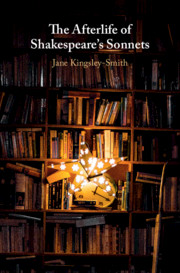36 results
1. - Critical Studies
- from The Year’s Contribution To Shakespeare Studies
-
-
- Book:
- Shakespeare Survey 75
- Published online:
- 24 August 2022
- Print publication:
- 08 September 2022, pp 361-374
-
- Chapter
- Export citation
1. - Critical Studies
- from The Year’s Contribution to Shakespeare Studies
-
-
- Book:
- Shakespeare Survey 74
- Published online:
- 28 August 2021
- Print publication:
- 16 September 2021, pp 397-411
-
- Chapter
- Export citation
Chapter 1 - Loved When They Alteration Find, 1598–1622
-
- Book:
- The Afterlife of Shakespeare's Sonnets
- Published online:
- 16 August 2019
- Print publication:
- 29 August 2019, pp 12-53
-
- Chapter
- Export citation
Chapter 5 - A Waste of Shame, 1901–1997
-
- Book:
- The Afterlife of Shakespeare's Sonnets
- Published online:
- 16 August 2019
- Print publication:
- 29 August 2019, pp 191-242
-
- Chapter
- Export citation
Dedication
-
- Book:
- The Afterlife of Shakespeare's Sonnets
- Published online:
- 16 August 2019
- Print publication:
- 29 August 2019, pp v-vi
-
- Chapter
- Export citation
Chapter 3 - One Thing to My Purpose Nothing, 1709–1816
-
- Book:
- The Afterlife of Shakespeare's Sonnets
- Published online:
- 16 August 2019
- Print publication:
- 29 August 2019, pp 96-134
-
- Chapter
- Export citation
Contents
-
- Book:
- The Afterlife of Shakespeare's Sonnets
- Published online:
- 16 August 2019
- Print publication:
- 29 August 2019, pp vii-vii
-
- Chapter
- Export citation
References
-
- Book:
- The Afterlife of Shakespeare's Sonnets
- Published online:
- 16 August 2019
- Print publication:
- 29 August 2019, pp 251-278
-
- Chapter
- Export citation
Introduction
-
- Book:
- The Afterlife of Shakespeare's Sonnets
- Published online:
- 16 August 2019
- Print publication:
- 29 August 2019, pp 1-11
-
- Chapter
- Export citation
Acknowledgements
-
- Book:
- The Afterlife of Shakespeare's Sonnets
- Published online:
- 16 August 2019
- Print publication:
- 29 August 2019, pp ix-x
-
- Chapter
- Export citation
Copyright page
-
- Book:
- The Afterlife of Shakespeare's Sonnets
- Published online:
- 16 August 2019
- Print publication:
- 29 August 2019, pp iv-iv
-
- Chapter
- Export citation
Conclusion
-
- Book:
- The Afterlife of Shakespeare's Sonnets
- Published online:
- 16 August 2019
- Print publication:
- 29 August 2019, pp 243-250
-
- Chapter
- Export citation
Index
-
- Book:
- The Afterlife of Shakespeare's Sonnets
- Published online:
- 16 August 2019
- Print publication:
- 29 August 2019, pp 279-286
-
- Chapter
- Export citation
Chapter 4 - As With Your Shadow I With These Did Play, 1817–1900
-
- Book:
- The Afterlife of Shakespeare's Sonnets
- Published online:
- 16 August 2019
- Print publication:
- 29 August 2019, pp 135-190
-
- Chapter
- Export citation
Chapter 2 - Annals of All-Wasting Time, 1623–1708
-
- Book:
- The Afterlife of Shakespeare's Sonnets
- Published online:
- 16 August 2019
- Print publication:
- 29 August 2019, pp 54-95
-
- Chapter
- Export citation
Figures
-
- Book:
- The Afterlife of Shakespeare's Sonnets
- Published online:
- 16 August 2019
- Print publication:
- 29 August 2019, pp viii-viii
-
- Chapter
- Export citation

The Afterlife of Shakespeare's Sonnets
-
- Published online:
- 16 August 2019
- Print publication:
- 29 August 2019
‘Let me not to the Marriage of True Minds’: Shakespeare’s sonnet for Lady Mary Wroth
-
-
- Book:
- Shakespeare Survey
- Published online:
- 13 October 2016
- Print publication:
- 06 October 2016, pp 292-301
-
- Chapter
- Export citation
Character and the Individual Personality in English Renaissance Drama: Tragedy, History, Tragicomedy. John E. CurranJr . Newark: University of Delaware Press, 2014. xxiv + 334 pp. $95.
-
- Journal:
- Renaissance Quarterly / Volume 69 / Issue 1 / Spring 2016
- Published online by Cambridge University Press:
- 20 November 2018, pp. 388-390
- Print publication:
- Spring 2016
-
- Article
- Export citation
Contributors
-
-
- Book:
- Shakespeare and Renaissance Ethics
- Published online:
- 05 August 2014
- Print publication:
- 24 July 2014, pp vii-viii
-
- Chapter
- Export citation

